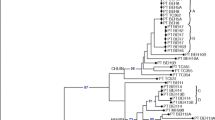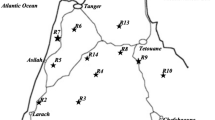Abstract
Sweet potato (Ipomoea batatas L.) is the fifth most important crop in the developing countries after rice, wheat, maize and cassava. The amplified fragment length polymorphism (AFLP) method was used to study the genetic diversity and relationships of sweet potato accessions in the germplasm collection of Sokoine University of Agriculture, Morogoro and Sugarcane Research Institute, Kibaha, Tanzania. AFLP analysis of 97 sweet potato accessions using ten primer combinations gave a total of 202 clear polymorphic bands. Each one of the 97 sweet potato accessions could be distinguished based on these primer combinations. Estimates of genetic similarities were obtained by the Dice coefficient, and a final dendrogram was constructed with the un-weight pair-group method using arithmetic average. AFLP-based genetic similarity varied from 0.388 to 0.941, with a mean of 0.709. Cluster analysis using genetic similarity divided the accessions into two main groups suggesting that there are genetic relationships among the accessions. Principal Coordinate analysis confirmed the pattern of the cluster analysis. Analysis of molecular variance revealed greater variation within regions (96.19%) than among regions (3.81%). The results from the AFLP analysis revealed a relatively low genetic diversity among the germplasm accessions and the genetic distances between regions were low. A maximally diverse subset of 13 accessions capturing 97% of the molecular markers diversity was identified. We were able to detect duplicates accessions in the germplasm collection using the highly polymorphic markers obtained by AFLP, which were found to be an efficient tool to characterize the genetic diversity and relationships of sweet potato accessions in the germplasm collection in Tanzania.



Similar content being viewed by others
References
Austin DF (1977) Hybrids polyploids in Ipomoea section Batatas. J Hered 68:259–260
Austin DF (1988) The taxonomy, evolution and genetic diversity of sweet potato and related wild species. In: Gregory P (ed) Exploration, maintenance, and utilization of Sweet potato genetic resources. International Potato Center, Lima, Peru, pp. 27–60
Bonants PJM, Hagenaar-de Weerdt M, Man in't Veld WA, Baayen RP (2000) Molecular characterization of natural hybrids of Phytophthora nicotianae and P. cactorum. Phytopathology 90:867–874
Bouwkamp JC (1985) Introduction-Part1. In: Bouwkamp JC (eds), Sweet potato products: A natural resource for the tropics. CRC Press, Inc Boca Raton FL
CIP (1999). Sweetpotato Facts, a compendium of key figures and analysis for 33 important sweetpotato-producing countries. International Potato Center, Lima, Peru
Connolly AG, Godwin ID, Cooper M, Delacy IH (1994) Interpretation of randomly amplified polymorphic DNA marker data for fingerprinting sweet-potato (Ipomoea batatas L.) genotypes. Theor Appl Genet 88:332–336
Dice LR (1945) Measures of the amount of ecologic association between species. Ecology 26:297–302
Eikemo H, Klemsdal SS, Riisberg I, Bonants P, Stensvand A, Tronsmo AM (2004) Genetic variation between Phytophthora cactorum isolates differing in their ability to cause crown rot in strawberry. Mycological Res 108:317–324
Excoffier L, Smouse PE, Quattro JM1 (1992) Analysis of molecular variance inferred from metric distances among DNA haplotypes: application to human mitochondrial DNA restriction data. Genetics 131:479–491
Excoffier L, Smouse PE (1994) Using allele frequencies and geographic subdivision to reconstruct gene trees within a species molecular variance parsimony. Genetics 136:343–359
Fajardo DD, La Bonte DR, Jarret RL (2002) Identifying and selecting genetic diversity in Papua New Guinea sweet potato Ipomoea batatas (L.) Lam. Germplasm collected as botanical seed. Genet Resour Crop Evol 49:463–470
FAO, Production Yearbook (2004) FAE Statistic Series No 134. Rome, Italy
Gepts P (1993) The use of molecular and biochemical markers in crop evolution studies. Evol Bio 27:51–94
Gichuki ST, Berenyi M, Zhang DP, Hermann M, Schmidt J, Glossl J, Burg K (2003) Genetic diversity in sweet potato (Ipomoea batatas (L.) in relationship to geographic sources as assessed with RAPD markers. Genet Resour Crop Evol 50:429–437
Harper JL (1977) Population biology of plants. Academic Press, London, p. 892
He GH, Prakash CS, Jarret Rl (1995) Analysis of genetic diversity in sweet potato (Ipomoea batatas) germplasm collection using DNA amplification fingerprinting. Genome 38:938–945
Hu J, Nakatani M, Lalusin A, Kuranouchi T, Fujimura T (2003) Genetic analysis of sweet potato and wild relatives using Inter-simple Sequence Repeats (ISSRs). Breed Sci 53:297–304
Huaman Z, Zhang DP (1997) Sweet potato. In: Fuccillo D, Sears L, Stapleton P (eds) Biodiversity in trust. Cambridge University Press, Cambridge, UK, pp. 29–38
Huaman Z (1999) Botany, origin, evolution and biodiversity of the sweet potato. In: Huaman Z (eds) Sweet potato Germplasm Management Training Manual. International Potato Center, Lima Peru, pp. 1–11
Huaman Z, Aguilar C, Ortiz R (1999) Selecting a Peruvian sweetpotato core collection on the basis of morphological, eco-geographical, and disease and pest reaction data. Theor Appl Genet 98:840–844
Huang JC, Sun M (2000) Genetic diversity and relationships of sweet potato and its wild relatives in Ipomoea series batatas (Convolvulaceae) as revealed by inter-simple sequence repeat (ISSR) and restriction analysis of chloroplast DNA. Theor Appl Genet 100:1050–1060
Huang J, Corke H, Sun M (2002) Highly polymorphic AFLP markers as a complementary tool to ITS sequences in assessing genetic diversity and phylogenetic relationships of sweet potato (Ipomoea batatas (L.) Lam.) and its wild relatives. Genet Resour Crop Evol 49:541–550
Hwang SY, Tseng YT, Lo HF (2002) Application of simple sequence repeats in determining the genetic relationships of cultivars used in sweet potato polycross breeding in Taiwan. Sci Hortic 93:215–224
Jaccard P (1908) Nouvelles recherches sur la distribution florale. Bull Soc Vaud Sci Nat 44:223–270
Kapinga R, Ewell PT, Jeremiah SC, Kileo R (1995) Sweet potato in Tanzanian farming and food system: Implications for Research. A farming systems survey report. Tanzania National Root and Tuber Crops and Farming Systems Research Programme and the International Potato Centre, Nairobi, Kenya
Kennedy LS, Thompson PG (1991) Identification of sweet-potato cultivars using isozyme analysis. Hortscience 26:300–302
Kuo CG (1991) Conservation and distribution of sweet potato germplasm. In: Dodds JH (eds) In Vitro methods for Conservation of Plant Genetic Resources, Chapman and Hall, New York, pp. 123–147
McGregor CE, Lambert CA, Greyling MM, Louw JH, Warnich L (2000) A comparative assessment of DNA fingerprinting techniques (RAPD, ISSR, AFLP and SSR) in tetraploid potato (Solanum tuberosum L.) germplasm. Euphytica 113:135–144
Mok I, Zhang D, Carey E (1997) Sweet potato breeding strategy of CIP. In LaBonte D.R., Yamashita M., and Mochida H. (eds.) Proceedings of international workshop on sweet potato production system towards the 21st Century. Dec 1997:9–27
National Research Council (1993) Agricultural crop issues and policies: managing global genetic resources, vol. I. National Research Council (U.S.A.), Washington, D.C
Powell W, Morgante M, Andre C, Hanafey M, Vogel J, Tingey S, Rafalski A (1996) The comparison of RFLP, RAPD, AFLP and SSR (microsatellite) markers for germplasm analysis. Mol Breed 3:225–238
Prakash CS, He GH, Jarret RL (1996) DNA marker-based study of genetic relatedness in United States sweetpotato cultivars. J Am Soc Hortic Sci 121:1059–1062
Rao VR, Debouck T, Iwanga M (1994) The role of international organisations in root and tuber crop conservation. In: The first ministry of Agriculture, Forestry and Fisheries, Japan International Workshop on Genetic Resources – Root and Tuber Crops, 15–17 March 1994, Tsukuba, MAFF, Japan, pp. 7–22
Rohlf FJ (2000) NTSYS-pc, numerical taxonomy and multivariate analysis system, v.2.02. New York: Exeter software
Sagredo B, Hinrichsen P, López H, Cubillos A, Munoz C (1998) Genetic variation of sweet potatoes (Ipomoea batatas L.) cultivated in Chile determined by RAPDs. Euphytica 101:193–198
Schneider R, Roessli D, Excoffier L (2000) Arlequin: A software for Population Genetics Data Analysis, Version 2.000 Genetic and Biometry Laboratory. Department of Anthropology, University of Geneva, Switzerland
Schultheis JR, Cantliffe DJ, Bryan HH (1994) Early plant-growth and yield of sweet-potato grown from seed, vegetative cuttings, and somatic embryos J Amer Soc Hort Sci 119:1104–1111
Sneath PA, Sokal RR (1973) Numerical taxonomy. Freeman, San Francisco
Tseng YT, Lo HF, Hwang SY (2002) Genotyping and assessment of genetic relationships in elite polycross breeding cultivars of sweet potato in Taiwan based on SAMPL polymorphisms. Bot Bull Acad Sinica 43:99–105
Ugent D, Peterson LW (1988) Archaeological remains of potato and sweet potato in Peru. CIP Circular 16:1–10
Vaughan JG, Geissler CA (1997) The new Oxford book of food plants. Oxford University Press, Oxford, UK
Vos P, Hogers R, Bleeker M, Reijans M, van de Lee T, Hornes M, Freijters A, Pot J, Peleman J, Kuiper M, Zabeau M (1995) AFLP: a new technique for DNA fingerprinting. Nucleic Acids Res 23:4407–4414
Wambugu FM (2003) Development and transfer of genetically modified virus-resistant sweet potato for subsistence farmers in Kenya. Nutrition Reviews 61:110–113
Woolfe JA (1992) Sweet potato, an untapped food resource. Cambridge University Press, New York
Zhang D, Ghislain M, Huaman Z, Golmirzaie A, Hijmans R (1998) RAPD variation in sweet potato (Ipomoea batatas (L.) Lam.) cultivars from South America and Papua New Guinea. Genet Resour Crop Evol 45:271–277
Zhang D, Cervantes J, Huaman EC, Ghislain M (2000) Assessing genetic diversity of sweet potato (Ipomoea batatas (L.) Lam.) cultivars from tropical America using AFLP. Genet Resour Crop Evol 47:659–665
Zhang D, Rossel G, Kriegner A, Hijmans R (2004) AFLP assessment of diversity in sweet potato from Latin America and the Pacific region: Its implications on the dispersal of the crop. Genet Resour Crop Evol 51:115–120
Acknowledgement
The authors would like to thank the staff at the germplasm centers of The Sugarcane Research Institute, Kibaha and at Sokoine University of Agriculture, Morogoro, Tanzania, for their cooperation and for supplying us with sweet potato accessions used in the study. This work has been partly supported by NORAD (Norwegian Agency for Development Cooperation, project 021 TARPII-SUA).
Author information
Authors and Affiliations
Corresponding author
Rights and permissions
About this article
Cite this article
Elameen, A., Fjellheim, S., Larsen, A. et al. Analysis of genetic diversity in a sweet potato (Ipomoea batatas L.) germplasm collection from Tanzania as revealed by AFLP. Genet Resour Crop Evol 55, 397–408 (2008). https://doi.org/10.1007/s10722-007-9247-0
Received:
Accepted:
Published:
Issue Date:
DOI: https://doi.org/10.1007/s10722-007-9247-0




